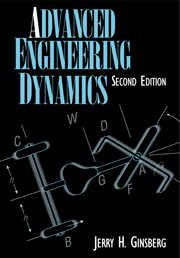Book contents
- Frontmatter
- Contents
- Preface
- Chapter 1 Basic Considerations
- Chapter 2 Particle Kinematics
- Chapter 3 Relative Motion
- Chapter 4 Kinematics of Rigid Bodies
- Chapter 5 Newtonian Kinetics of a Rigid Body
- Chapter 6 Introduction to Analytical Mechanics
- Chapter 7 Further Concepts in Analytical Mechanics
- Chapter 8 Gyroscopic Effects
- Appendix Centroidal Inertia Properties
- Answers to Even-Numbered Problems
- Index
Chapter 7 - Further Concepts in Analytical Mechanics
Published online by Cambridge University Press: 05 June 2012
- Frontmatter
- Contents
- Preface
- Chapter 1 Basic Considerations
- Chapter 2 Particle Kinematics
- Chapter 3 Relative Motion
- Chapter 4 Kinematics of Rigid Bodies
- Chapter 5 Newtonian Kinetics of a Rigid Body
- Chapter 6 Introduction to Analytical Mechanics
- Chapter 7 Further Concepts in Analytical Mechanics
- Chapter 8 Gyroscopic Effects
- Appendix Centroidal Inertia Properties
- Answers to Even-Numbered Problems
- Index
Summary
The basic principles in the preceding chapters provide a sufficient foundation to treat the majority of modeling tasks that arise in engineering practice. Our goal in this chapter is to expand these capabilities. The first priority is to be able to apply Lagrange's equations in situations where constrained generalized coordinates have been selected. We will find that such a description might be desirable, even if the system is holonomic, especially if friction is present in the system.
We will also develop alternative, and sometimes simpler, forms of the equations of motion. Those developments are partially intended to assist the phase of a dynamics study in which the equations of motion are solved. However, they also will enhance our understanding of the basic concepts of analytical mechanics, and their relationship to the principles of Newtonian mechanics.
Constrained Generalized Coordinates
Whenever we formulate equations of motion using more generalized coordinates than the number of degrees of freedom, we must deal with constrained generalized coordinates. This is unavoidable in the case of a nonholonomic system. The key feature of such formulations is the need to account for constraint forces in the equations of motion. Also, because the number M of generalized coordinates exceeds the number N of degrees of freedom, there are M–N constraint conditions that must be explicitly satisfied. Such conditions may be written as velocity constraints having the form of Eq. (6.3), even if a constraint is holonomic.
Information
- Type
- Chapter
- Information
- Advanced Engineering Dynamics , pp. 309 - 388Publisher: Cambridge University PressPrint publication year: 1995
